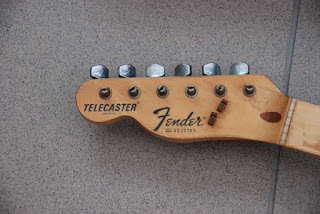1977 Telecaster restoration - Part 2 - The neck
The reason to start with the neck is pretty obvious: laziness ;-)
If you can't get the neck in reasonable shape, you might as well sell the guitar for parts because this means you won't be able to play that guitar. Every other part you could consider replacing and still have a guitar with a reasonable and authentic feel about it. This is the most 'make or break' part of any guitar when it comes to value.
Let's take a look at some 'before' pics:
If you can't get the neck in reasonable shape, you might as well sell the guitar for parts because this means you won't be able to play that guitar. Every other part you could consider replacing and still have a guitar with a reasonable and authentic feel about it. This is the most 'make or break' part of any guitar when it comes to value.
Let's take a look at some 'before' pics:
Let's make an inventory what needs to be improved:
- hardware: the tuners are stuck and the string guides and neck plate are rusted pretty bad
- frets are also in very bad shape
- and the most worrying: the fretboard has pealed of ar the bottom and is showing slight detachment on the top. The edges are sharp on both sides which makes this nearly impossible to play.
1. Hardware
Let's start by removing the hardware (not the tuners) and putting them in a bath of vinegar. Vinegar is and acid that will soak loose the rust a bit (including screws.
It takes quite some time to see results. But after a day pass gently with some '0000' steel wool across it and repeat this one more time.
After the second time, you can consider rubbing aluminium foil with water up against the parts to fill the gaps of finish and prevent it from rusting again. this works rather well ;-)
The tuners, spray some cleaning oil inside them and try to loosen them up. Do this gently, a bit at a time and repeat this a couple of days if needed. I used WD-40, but that's a brand, so any oil based cleaning spray will probably do.
I'm pretty pleased with the results:
(sorry... forgot to take a picture of the neck plate)
2. Frets
To clean the frets, I use a simple but efficient trick. I stik some painters tape next to each side or the fret and rub some 0000 steel wool like crazy against the fret. The result is amazing:
Now it's also clear that there is slight freeware, but considering the age of the guitar, it's pretty fine.
I also use this trick for regular maintenance of a guitar, but keep in mind to cover the pickups is you do this with the neck attached. The magnets attract all the steel 'dust' when doing this, and that is not something you'd want.
3. Fretboard
And than the part that worried me the most: the fretboard. Maple fretboards are far more delicate than rosewood fretboards because of the finish. It is not rare that at some point the finish detaches a little from the board. In this case, it's a far evolved state, resulting in an actual unplayable board. Simply running your hand across is would cut it.
So what I did to fix this is to sand off the sharp edges and try to level the finish with the bard at the edges. Notice I tried to avoid any wood sanding the best i could. Sanding the wood would result in a difference the would be impossible to fix.
After this, I put some transparent urethane on it. The is an amazing product since it's completely transparent and very thin (rub-on/rob-off principle). I had to repeat this operation a (huge) number of times to get to a reasonable result. The color difference is in the wood, and has nothing to do with the urethane.
Very pleased to say the result is a playable neck. (I also checked the trussrod and it is ok - did that earlier on ;-))
To get the rest clean up I polished everything with some turtle wax. Pleased with the result!









Reacties
Een reactie posten